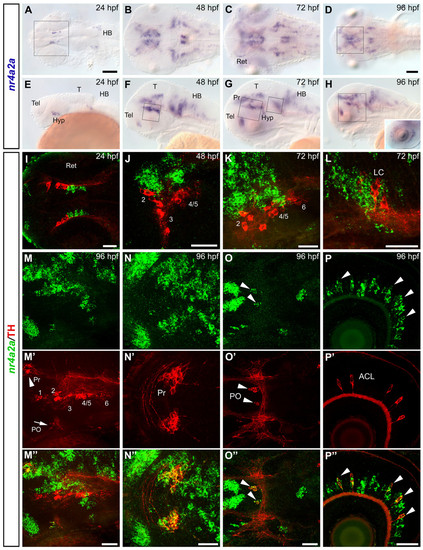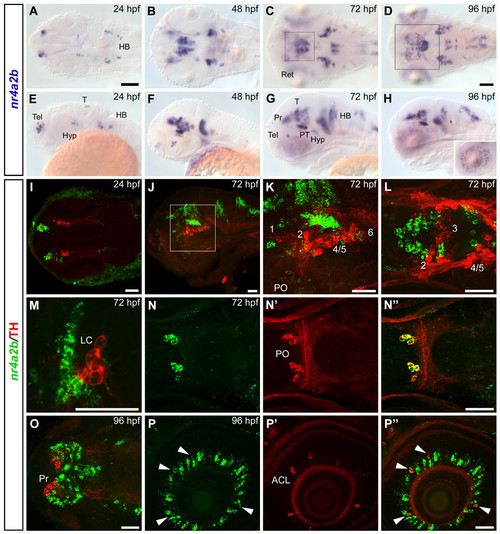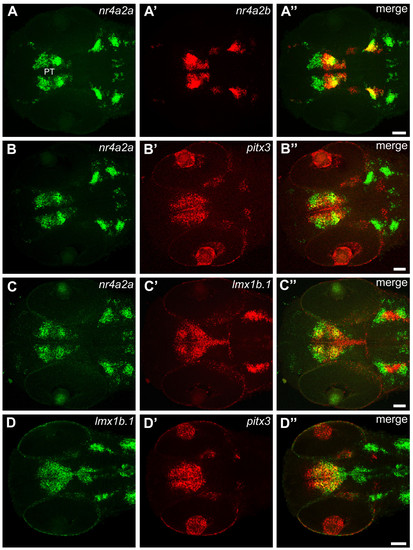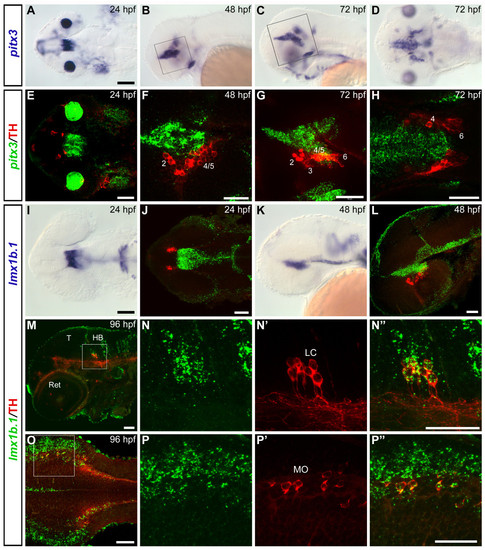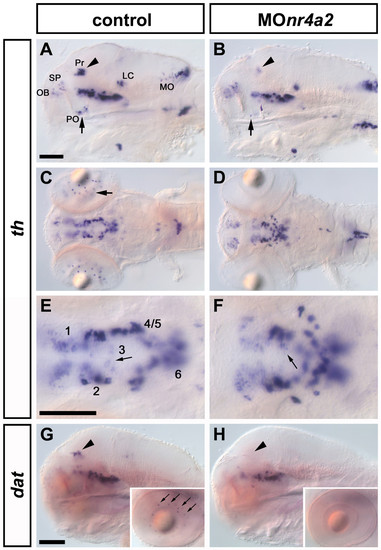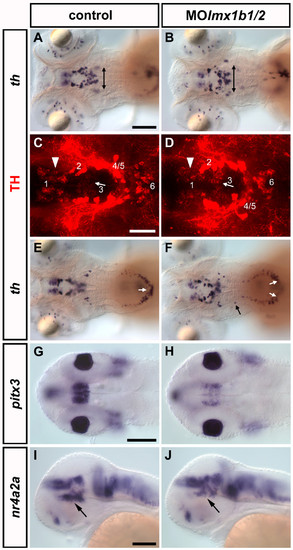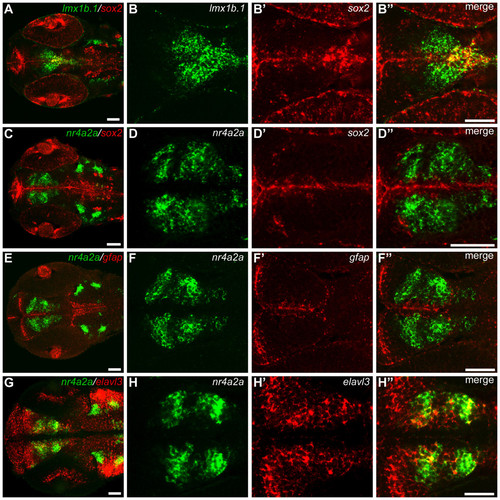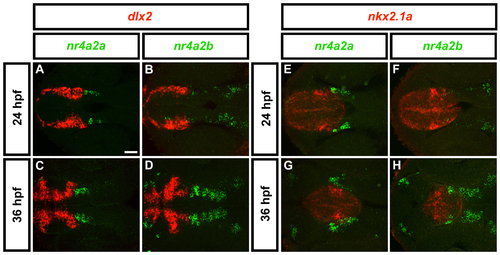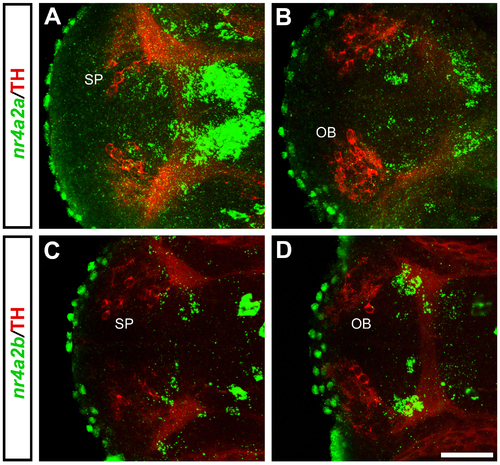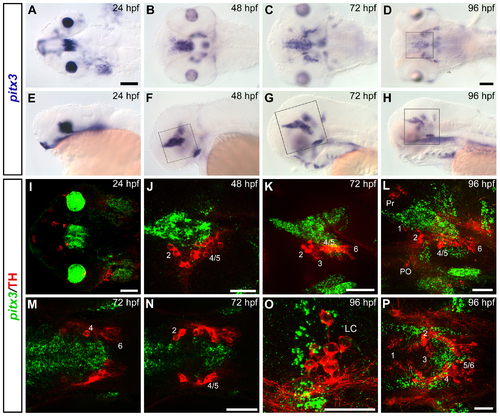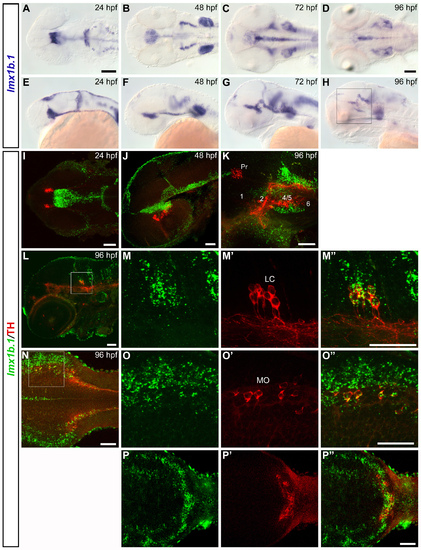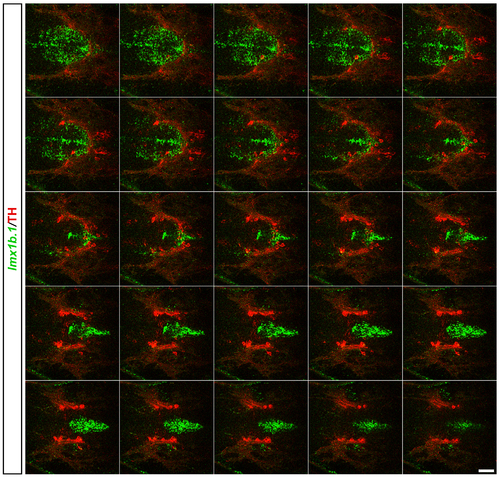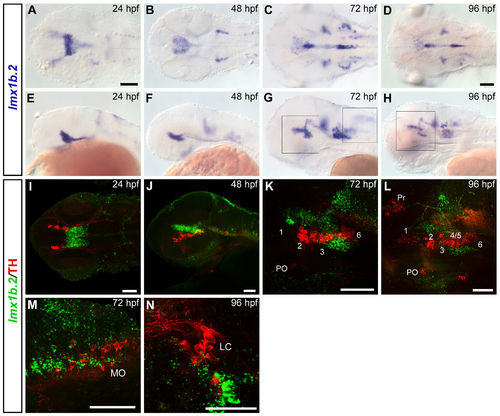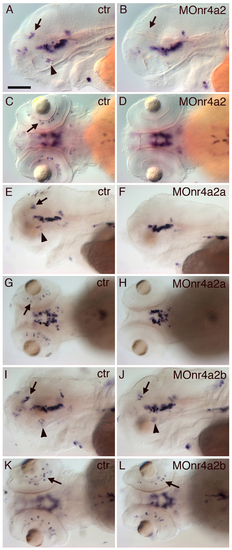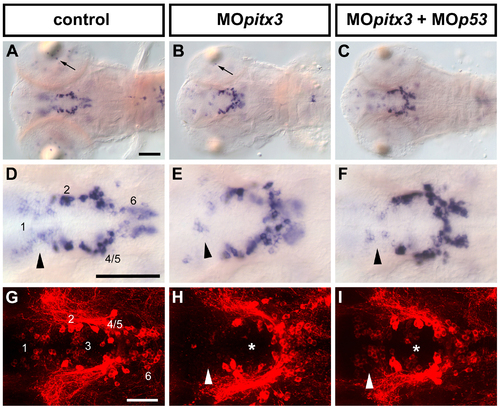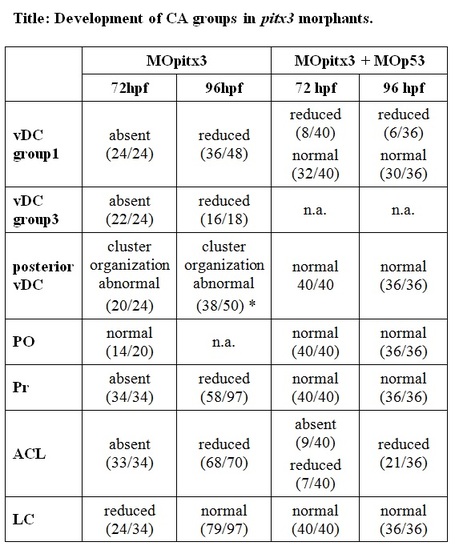- Title
-
Expression and function of nr4a2, lmx1b, and pitx3 in zebrafish dopaminergic and noradrenergic neuronal development
- Authors
- Filippi, A., Duerr, K., Ryu, S., Willaredt, M., Holzschuh, J., and Driever, W.
- Source
- Full text @ BMC Dev. Biol.
|
nr4a2a is co-expressed with TH in DA neurons of the pretectum, the preoptic area and in amacrine cells of the retina. (A-H) Whole mount in situ hybridization showing nr4a2a expression pattern at 24 hpf (A, E), 48 hpf (B, F), 72 hpf (C, G) and 96 hpf (D, H). Dorsal (A-D) and lateral (E-H) views of the head, anterior is to the left. (I-P″) The spatial relationship between nr4a2a-expressing cells and CA neurons in different areas of the brain was analyzed by whole mount FISH to nr4a2a (green) and anti-TH immunohistochemistry (red). Expression was documented by confocal stacks of images, and information for regions corresponding to specific CA neuronal groups was summarized by generation of z-projections from subsets of focal planes of these stacks. (I) Dorsal overview of a 24 hpf embryo (35 μm projection, the approximate head region framed in A is shown): the THir domain is located anterior to the diencephalic nr4a2a domain but there is no co-expression. (J) High magnification of the diencephalic DA clusters at 48 hpf (18 μm projection, approximate area framed in F). (K) High magnification of the diencephalic DA clusters at 72 hpf (15 μm projection, approximate area delimited by the big frame in G). (L) High magnification of the region of the locus coeruleus at 72 hpf (6 μm projection, approximate area delimited by the small frame in G). (M-M″) Lateral view of a 96 hpf embryo showing the brain region framed in H (23 μm projection): nr4a2a (green channel, M) and TH (red channel, Mμ); co-expression is detectable in the pretectum (Pr, arrowhead in Mμ) and in the preoptic area (PO, arrow in Mμ) (merged channels: M″). High magnification dorsal views of the pretectal area and the preoptic dopaminergic neurons are shown respectively in N-N″ (6 μm projection, approximate area framed in D) and in O-O″ (11 μm projection, arrowheads). (P-P″) nr4a2a is expressed in numerous cells of the inner nuclear layer of the retina (P and inset in H), and in all THir amacrine cells (P′-P″, arrowheads). In this and in the following figures the DA groups in the ventral diencephalon are numbered from 1 to 6, according to [28]. I, N-N″, O-O″, dorsal views; J, K, L, M-M″, P-P″, lateral views; anterior is to the left. Scale bar in A for A-C, E-G and in D for D, H: 100 μm; scale bars in I-P″: 50 μm. Abbreviations: ACL, amacrine cell layer; HB, hindbrain; Hyp, hypothalamus; LC, locus coeruleus; PO, preoptic area; Pr, pretectum; T, tectum; Tel, telencephalon; Ret, retina. |
|
nr4a2b is co-expressed with TH in the DA neurons of the preoptic area and in the amacrine cells of the retina. (A-H) Whole mount in situ hybridization showing nr4a2b expression pattern at 24 hpf (A, E), 48 hpf (B, F), 72 hpf (C, G) and 96 hpf (D, H). Dorsal (A-D) and lateral (E-H) views of the head are represented, anterior is to the left. (I-P″) The spatial relationship between nr4a2b-expressing cells and CA neurons in different areas of the brain was analyzed by whole mount FISH to nr4a2b (green) and anti-TH immunohistochemistry (red). (I) Dorsal view (56 μm projection) of the head at 24 hpf. (J) Lateral overview (21 μm projection through the diencephalic DA groups) of a 72 hpf embryo. Scattered cells among THir neurons express nr4a2b but double labeled cells are not detectable in this region. A higher magnification of the framed area in J is showed in K (15 μm projection), and a dorsal view of the diencephalic clusters at the same developmental stage is presented in L (9 μm projection). (M) Single confocal plane showing the close proximity of nr4a2b-expressing cells to the THir NA neurons of the locus coeruleus at 72 hpf. Similar to nr4a2a, nr4a2b is co-expressed with TH in the preoptic area (N-N″, 12 μm projection, 72 hpf) and in the amacrine cells of the retina (arrowheads in P-P″, 7 μm projection, 96 hpf), but no co-expression is detectable in the pretectum at 96 hpf (O, 4 μm projection, approximate area framed in D). I, L, M, N-N″, O, dorsal views; J, K, P-P", lateral views; anterior is to the left. Scale bar in A for A-C, E-G and in D for D, H: 100 μm; scale bars in I-P": 50 μm. Abbreviations: ACL, amacrine cell layer; HB, hindbrain; Hyp, hypothalamus; LC, locus coeruleus; PO, preoptic area; Pr, pretectum; PT, posterior tuberculum; T, tectum; Tel, telencephalon; Ret, retina. |
|
Areas of co-expression between nr4a2a/b, pitx3 and lmx1b.1 in the posterior tuberculum. (A-D″) Confocal z-projections of double whole mount FISH at 48 hpf show overlapping expression domains for nr4a2a/b, pitx3 and lmx1b.1. The projections encompass the focal planes through the ventral diencephalon. The antisense probes used for the FISH are indicated on the top of each panel. (A-A″) 28 μm projection; (B-B″) 19 μm projection; (C-C″) 16 μm projection; (D-D″) 13 μm projection. Anterior is to the left. Scale bars: 50 μm. Abbreviation: PT, posterior tuberculum. EXPRESSION / LABELING:
|
|
Expression domains of pitx3 and lmx1b.1 genes in relation to catecholaminergic groups. (A-D) Whole mount in situ hybridization showing pitx3 expression pattern at 24 hpf (A, dorsal view), 48 hpf (B, lateral view) and 72 hpf (C, lateral view, and D, dorsal view). (E-H) Confocal z-projections of whole mount FISH to pitx3 (green) and anti-TH immunohistochemistry (red) revealing the spatial relationship between pitx3-expressing and THir cells. (E) Dorsal overview of the head at 24 hpf (35 µm projection). (F) Single plane confocal image of a 48 hpf embryo, the approximate diencephalic area framed in B is showed. (G) Lateral view (38 µm projection) of a 72 hpf embryo (area framed in C). (H) Single dorsal plane showing the diencephalic area of a 72 hpf embryo: pitx3 expression is mainly detectable in medial and dorsal position with respect to the THir neurons of the posterior tuberculum, and no co-localization can be detected with any DA group (see also additional file 5). (I-L) Expression profile of lmx1b.1 at 24 hpf (I-J) and 48 hpf (K-L) analyzed by traditional WISH (I, K) or by whole mount FISH (J, L, green) and anti-TH immunohistochemistry (J, L, red). Dorsal (I-J) and lateral (K-L) views are represented. J and L are 35 μm and 17 μm confocal projections respectively. No co-expression of lmx1b.1 and TH is detected in the DA neurons of the posterior tuberculum. Double labelling is instead observed in the NA neurons of the locus coeruleus (LC) (M-N″) and medulla oblongata (MO) (O-P″). (M) Single confocal image at the level of the locus coeruleus of a 96 hpf embryo. High magnification of the framed area is showed in N-N" (23 μm projection). (O) Dorsal overview of the medulla oblongata in a 96 hpf embryo (4 µm projection). A high magnification of the framed area is showed in P-P" (single plane) (see also additional files 6 and 7). Anterior is always to the left. Scale bars in A and I (for A-D and I, K): 100 μm; all the other scale bars: 50 μm. Abbreviations: HB, hindbrain; LC, locus coeruleus; MO, medulla oblongata; T, tectum; Ret, retina. |
|
Nr4a2a is required for formation of DA neurons in pretectum, preoptic area and retina. Morphants were analyzed by WISH to detect th expression at 96hpf. (A) Embryos injected with control morpholino show normal formation of CA groups, including DA nuclei in the pretectum (arrowhead) and the preoptic region (arrow). (B) Injection of 2ng MOnr4a2, which targets both nr4a2 genes, leads to a strong reduction of DA neurons in the pretectum (arrowhead) and the preoptic region (arrow). (C) Control morphants form DA amacrine cells in the retina (arrow), which are absent or strongly reduced in embryos injected with MOnr4a2 (D). All the ventral diencephalic DA groups develop in the nr4a2 morphant embryos (F), including group 3 (arrow), although the spatial organization of the neurons appears altered when compared to control embryos (E). (G-H) When dat expression was analyzed (G, H), nr4a2 morphants showed lack of DA neurons in the pretectum (H, arrowhead), in the retina (inset in H) and the preoptic area (not shown). A-B, G-H: lateral views; C-F: dorsal views. Anterior is to the left. Scale bars in A for A-B, in E for E-F and in G for G-H: 100 μm. Abbreviations: LC, locus coeruleus; MO, medulla oblongata; OB, olfactory bulb; PO, preoptic area; Pr, pretectum; SP, subpallium. |
|
Loss of lmx1b.1 and lmx1b.2 changes the spatial organization of CA cell bodies in the vDC and the hindbrain. (A) Embryos injected with control morpholino display a normal development of DA neurons in the vDC. (B) Embryos injected with both MOlmx1b1 and MOlmx1b2 similarly generate th expressing cells in the vDC, but they are dispersed towards lateral positions. (C, D) Confocal analysis of anti-TH immunostaining shows that vDC group 3 neurons develop normally in morphant embryos (D, arrow) compared to controls (C), while group 1 neurons are somewhat reduced (D, arrowhead). Confocal z-projections of 80 μm (C) and 74 μm (D) are reported. (E) Control morphant embryos form noradrenergic neurons in the area postrema (arrow), while (F) in the same area lmx1b.1 and lmx1b.2 double morphants show a gap of th expression (white arrows). Surprisingly, double morphants frequently exhibit ectopic th-expressing cells in the hindbrain (F, black arrow). (G-H) Analysis of pitx3 expression in control (G) and lmx1b.1/2 morphant embryo (H) at 28 hpf. The diencephalic expression domain of pitx3 is strongly reduced in MOlmx1b1/2 injected embryos. In addition, the most ventral diencephalic domain of nr4a2a expression is reduced in 48hpf morphant embryos (J, compare to I; arrows). A-H: dorsal views; I-J: lateral views. Anterior is to the left. Scale bars in A are for A-B, E-F, in G for G-H and in I are for I-J: 100 μm; scale bar in C is for C-D: 50 μm. EXPRESSION / LABELING:
PHENOTYPE:
|
|
nr4a2a is expressed in a population of differentiating neurons. (A-H″) Dorsal views of 48 hpf embryos hybridized with lmx1b.1 and sox2 (A-B″), nr4a2a and sox2 (C-D″), nr4a2a and gfap (E-F″), or nr4a2a and elavl3 (G-H″) probes show that nr4a2a is not expressed in progenitor cells, but in early differentiating cells. A, C, E and G show dorsal overviews of the head, at the level of the ventral diencephalon. High magnifications of the posterior tubercular area are reported on the right side of each overview. All the images are single confocal planes, except G, which is a 22 μm confocal projection. Anterior is to the left. Scale bars: 50 μm. EXPRESSION / LABELING:
|
|
Expression of nr4a2a and nr4a2b in relation to diencephalic expression domains of nkx2.1 and dlx2a. Early nr4a2a and nr4a2b expression domains were analyzed with relation to dlx2a and nkx2.1a domains by double FISH at 24 hpf (A-B, E-F) and 36 hpf (C-D, G-H). The combination of the different genes is indicated on top of the panels. The images are all confocal z-projections of the planes encompassing nr4a2a/b expression in the vDC. At these stages, both nr4a2a- and nr4a2b-expressing cells are detected posterior to the prethalamic marker dlx2a and dorsal to the hypothalamic marker nkx2.1a. Anterior is to the left. Scale bars: 50 μm. |
|
nr4a2 genes and TH are not co-expressed in the DA neurons of the olfactory bulb and subpallium. (A-D) Confocal z-projections of whole mount FISH to nr4a2a (A-B, green) or nr4a2b (C-D, green) combined with anti-TH immunohistochemistry (red). Neither nr4a2a nor nr4a2b is co-expressed with TH in the DA neurons of the subpallial area (A, C) and of the olfactory bulb (B, D). Dorsal views are presented, anterior is to the left. Scale bar: 50 μm. |
|
pitx3 and TH are not co-expressed in any CA group. (A-H) Whole mount in situ hybridization showing pitx3 expression pattern at 24 hpf (A, E), 48 hpf (B, F), 72 hpf (C, G) and 96 hpf (D, H). Dorsal (A-D) and lateral (E-H) views of the head are represented, anterior is to the left. (I-P) Confocal z-projections of whole mount FISH to pitx3 (green) and anti-TH immunohistochemistry (red) representing the spatial relationship between pitx3-expressing and THir cells. (I) Dorsal overview of the head at 24 hpf (35 μm projection). (J) Single plane confocal image of a 48 hpf embryo, the approximate diencephalic area framed in F is shown. (K) Lateral view (38 μm projection) of a 72 hpf embryo (area framed in G). (L) Lateral view (50 μm projection) of a 96 hpf embryo (frame in H). (M, N) Two different dorsal planes of the same confocal stack (M dorsal to N) showing the diencephalic area of a 72 hpf embryo: pitx3 expression is mainly detectable in medial and dorsal position with respect to the THir neurons of the posterior tuberculum, and no co-localization can be detected with any DA group. (O) Dorsal view (15 μm projection) of the locus coeruleus at 96 hpf. (P) Dorsal view (9 μm projection) of the DA groups in the diencephalon at 96 hpf (approximate area framed in D is shown). I, M, N, O, P dorsal views; J, K, L, lateral views; anterior is to the left. Scale bars in A for A-C, E-G and in D for D, H: 100 μm. Scale bars in I-P: 50 μm. |
|
lmx1b.1 is co-expressed with TH in the NA neurons of the locus coeruleus and medulla oblongata. (A-H) Whole mount in situ hybridization showing lmx1b.1 expression pattern at 24 hpf (A, E), 48 hpf (B, F), 72 hpf (C, G) and 96 hpf (D, H). Dorsal (A-D) and lateral (E-H) views of the head are represented, anterior is to the left. (I-P″) Confocal z-projections of whole mount FISH to lmx1b.1 (green) combined with anti-TH immunohistochemistry (red) representing the spatial relationship between lmx1b.1-expressing and THir cells. (I) Dorsal view (35 μm projection) of the head at 24 hpf. (J) Lateral view (17 μm projection) of a 48 hpf embryo. (K) High magnification of the diencephalic area (40 μm projection) in a 96 hpf embryo (approximate area framed in H). No co-expression of lmx1b.1 and TH is detected in the DA neurons of the posterior tuberculum. Double labelling is instead observed in the NA neurons of the locus coeruleus (L-M″) and medulla oblongata (N-O"), as well as of the area postrema (P-P″). (L) Single confocal image at the level of the locus coeruleus of a 96 hpf embryo. High magnification of the framed area is showed in M-M″ (23 μm projection). (N) Dorsal overview of the medulla oblongata in a 96 hpf embryo (4 μm projection). High magnification of the framed area is showed in O-O″ (single plane). (P-P″) 3 μm dorsal projection through the DA neurons of the area postrema. I, N, O-O″ dorsal views; J, K, L, M-M″ lateral views; anterior is to the left. Scale bars in A is for A-C, E-G and in D is for D, H: 100 μm. Scale bars in I-P″: 50 μm. |
|
lmx1b.1 expression in the ventral diencephalon does not overlap with TH in DA neurons. Gallery of 25 confocal images (1 μm apart from each other, from dorsal to ventral) representing the spatial relationship between lmx1b.1-expressing (green) and THir (red) cells in the ventral diencephalon. Anterior is to the left. Scale bar: 50 μm. |
|
lmx1b.2 is not co-expressed with TH in any CA group. (A-H) Whole mount in situ hybridization showing lmx1b.2 expression pattern at 24 hpf (A, E), 48 hpf (B, F), 72 hpf (C, G) and 96 hpf (D, H). Dorsal (A-D) and lateral (E-H) views of the head are represented, anterior is to the left. (I-N) Confocal z-projections of whole mount FISH to lmx1b.2 (green) followed by anti-TH immunohistochemistry (red) show the spatial relationship between lmx1b.2-expressing and THir cells. Although lmx1b.2-expressing cells in the diencephalon and in the hindbrain are often intermingled with THir neurons, no co-expression is observed in any of the CA groups. (I) Dorsal overview (32 μm projection) of a 24 hpf embryo. (J) Lateral overview (19 μm projection) of a 48 hpf embryo. (K) Lateral projection (57 μm) of the diencephalic area (framed in G). (L) Lateral projection (56 μm) of the framed region in H. (M) Lateral view (11 μm projection) of the NA neurons in the medulla oblongata at 72 hpf. (N) Dorsal view (6 μm projection) of the locus coeruleus at 96 hpf. Scale bar in A is for A-C, E-G and in D is for D, H: 100 μm. Scale bars in I-N′: 50 μm. |
|
Knock-down of nr4a2a and nr4a2b reveals different requirements for formation of DA neurons in pretectum, preoptic area and retina. Morphant embryos were analyzed for th expression by WISH at 72hpf. Embryos injected with control morpholino showed normal formation of CA groups, including DA neurons in the pretectum (A, arrow), the preoptic region (A, arrowhead) and in the retina (C, arrow). The injection of MOnr4a2, which targets both nr4a2 genes, leads to a strong reduction of DA neurons in the pretectum (B, arrow), in the preoptic region (C) and in the retina (D). The same phenotype is observed upon injection of a morpholino targeting only nr4a2a (MOnr4a2a) (E-F). However, the same DA groups are unaffected by injection of a morpholino targeting nr4a2b (MOnr4a2b) (I-L). Knock-down of nr4a2b leads only to a mild reduction of th expressing DA amacrine cells (L, arrow), as compared to controls (K, arrows). Scale bar: 100 μm. PHENOTYPE:
|
|
Knock-down of pitx3. pitx3 morphants were analyzed at 96hpf for th expression by WISH (A-F) and anti-TH immunohistochemistry (G-I), to better visualize groups 1 and 3 in the vDC. (A, D, G) Control embryos show normal development of DA neurons in the retina (A, arrow) and the vDC. (B, E, H) Embryos injected with 2ng MOpitx3 form fewer DA amacrine cells (arrow) and show reduced th expression in vDC groups 1 and 3 (E and H, arrowheads point to group 1 and the asterisk to group 3), besides a slight disorganization of the DA groups. Head and eye sizes are decreased as reported by Shi et al. (2005). (C, F, I) Upon co-injection of 2 ng MOpitx3 and 4,5 ng MOp53, the embryos display an almost complete recovery of vDC groups 1 and 3, suggesting that this pitx3 morpholino induces off-target effects which lead to an unspecific loss of these groups. A-I: dorsal views. Anterior is to the left. Scale bar in A is for A-C and in D is for D-F: 100 μm; scale bar in G for G-I: 50 μm. PHENOTYPE:
|
|
Development of CA groups in pitx3 morphants. The numbers in brackets represent the number of morphants that show the respective phenotypes and the total number of analyzed morphants. In MOpitx3 embryos, the posterior vDC DA clusters do form, but cells are often not as tightly organized into clusters as in control embryos (* ? in 19/50 morphants, th WISH stain intensity appeared stronger in morphants than in controls). CA clusters in the OB and MO are not included here, but may show a slight reduction of th expressing cells. Defects observed in MOpitx3 embryos are nearly completely compensated by co-injection of 2 ng MOpitx3 and 4,5 ng MOp53, indicating that the defects are caused by non-specific activation of p53, and that DA neurons may differentiate normally in the absence of Pitx3. Notes: (*) morphants with general morphological defects may sometimes form less DA cells. Abbreviations of the different CA groups: ACL, amacrine cell layer; vDC, ventral diencephalic; posterior vDC, ventral diencephalic groups from 2 and 4 to 6; LC, locus coeruleus; MO, medulla oblongata; OB, olfactory bulb; PO, preoptic area; Pr, pretectum. (n.a. ? not analyzed). PHENOTYPE:
|

